Synthetic Scents– Soaps may contain fragrances which are synthetic compounds that can lead to drying out or irritation of your skin.
Triethanolamine – is an ingredient common to branded soaps. This is a possible human carcinogen that is linked to other health problems. When this ingredient is present, three other chemicals also go along with this: sodium lauroyl sarcosinate, TEA-stearate and tocopherol. All these do not exempt from causing mild to serious health problems.
PEG-6 and sodium PCA – These chemicals are usually found in cleansing bar soaps, they may contain harmful impurities that are linked with cancer to other health problems. PEG-6, in particular is known to be linked to breast cancer.
Chemical surfactants–Sodium lauryl sulfate is usually added to increase the lather quality. According to, The Journal of The American College of Toxicology (ACT) in 1983, concentrations of sodium lauryl of as low as 0.5% could cause irritation. Here’s something to disturb you: Studies have shown that numerous soaps have concentrations of up to 30%. The ACT has reported this to be highly irritating and dangerous.
Propylene Glycol – a common ingredient in soaps, is a penetration enhancer. All these previously mentioned chemicals can be further activated, stimulated and enhanced by propylene glycol. This chemical poses risks of other health concerns.
Triclosan – a chemical used for its antibacterial properties, is an ingredient in many detergents, dish-washing liquids, soaps, deodorants, cosmetics, lotions, anti-microbial creams, various toothpastes. However, the safety of triclosan has been questioned in regard to environmental and human health. While the companies that manufacture products containing this chemical claim that it is safe, the United States Environmental Protection Agency (EPA) has registered it as a pesticide. The chemical formulation and molecular structure of this compound are similar to some of the most toxic chemicals on earth, relating it to dioxins and PCBs. The EPA gives triclosan high scores both as a human health risk and as an environmental risk.
All you need is a few types of vegetable oils, (or animal fats if you choose), water, and lye (caustic soda). Before anyone comments, yes I realise that it takes petroleum to harvest the plants that produce the oils, and if not sourced locally they have high food miles, however, you can source most from local producers if needs be, and we have a readily available source of olive oil in our region. The lye can also be produced from wood ash. Please, if using palm oil, purchase it from sustainable sources, and not the stuff they are burning down rainforests to plant.
If you want to see how it is made, I produced a YouTube video some time back which is embedded below.
It is an easy process, that only takes about 30 minutes.
Here is some soap that Kim and I made on Sunday from olive, sunflower, rice bran, and organic coconut oils. My recipe can be found at this post: Our Soap Recipe.
Here are the wooden moulds that we use. Kim lines them with cling wrap so that the liquid doesn’t leak out when poured into the mould.
The soap can be defrocked on about day two or three depending on if it has gone hard enough to keep its shape.
Once the cling wrap is removed, the soap can be cut into bars. Please note that the soap is still quite alkaline at this stage, so wear protective gloves as a precaution.
This one kilogram (2.2lbs) block is called Sandalwood and Musk. We only use essential oils as the fragrance in minute quantities.
The soap is still quite soft, so it is easy to cut into bars.
Here is the finished product for this block. 10 bars in total.
This block was made by splitting the liquid into two batches and adding two separate colours, then combining the batch in the mould. You actually get three colours if you only lightly mix the primary colour through the liquid soap before it sets.
This is the finished product for Berry. The two-kilogram block was cut into 24 bars.
The third block was Ocean fragrance, and again we divided the batch in two and only coloured one half. Once combined it looks like waves in the ocean.
Again, this made 24 bars of soap.
The next part of the process is curing the soap. For four weeks you need to turn each bar once daily. We have set up a trestle table in the front room and placed the bars on wire racks so they don’t stick to it. As the water evaporates and the lye further reacts with the oils, the bars harden and continue to do so over time. As with all soaps, don’t get it in your eyes, it stings!
The result is a nice, safe cleanser to wash yourself and your family with. Much better than that cocktail of chemicals they try and flog to us as soap!

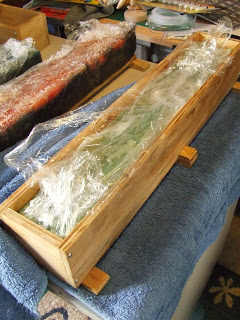
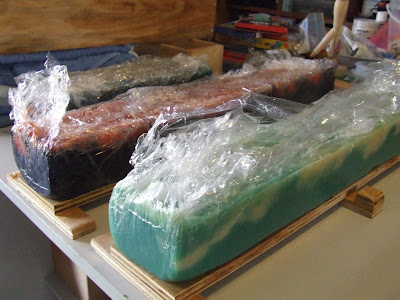
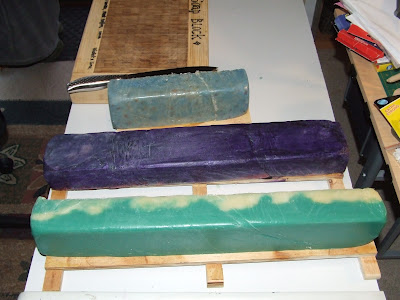
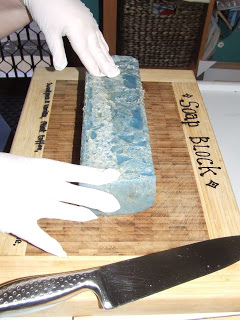
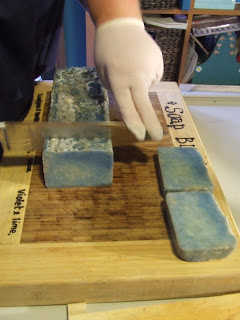
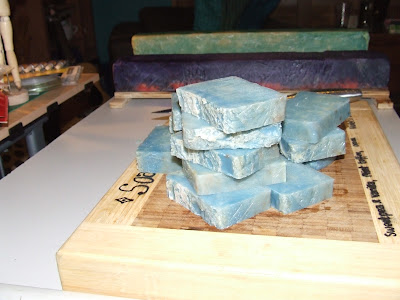
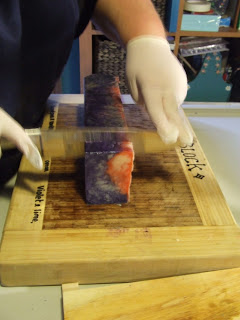
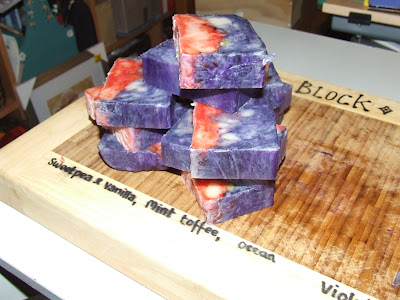

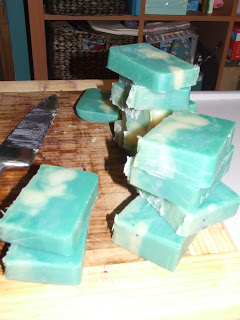

I wouldn’t recommend that people try to make their own lye from wood ash, particularly those just starting out. It will be extremely difficult to get a consistent strength and may result in lye-heavy batches and lye calculators will give incorrect results.
Much as it sounds wonderful to make your own from a waste product, don’t. Go to the hardware store and buy some. You will end up with a much more consistent product and you will ensure your own safety.
I’m not saying you are recommending that Gavin, but I can just see people reading that and thinking they’ll do it themselves. Thanks for a timely post. I’d better hurry up and order more Lavender EO so I can soap up a storm 🙂
Hi Monique. I agree. Wood ash is the last resort unless you know exactly what you are doing. I don’t, so I do not use it. Just demonstrating that if we face a long descent, we can still make some kind of soap!
Gav
I don’t know exactly what I’m doing with it either so I don’t use it. It would be interesting to learn though. I wonder if there are how to’s out there on the http://www... I know that running water through it is one of the steps. There’s got to be more to it than that though, and you would want to invest in a good pH test kit to ensure you get it right!!
Of course I generally keep enough lye in the cupboard for about 3 years worth of soap so I should be right if we face a long descent lol.
Hey how do you find coconut oil in your soaps? I’ve been using palm because I have it, but once that’s used up I won’t be buying it again. Does coconut give the same hardness to the bars that palm does?
Hope you don’t mind Gav but I just penned a short article on my blog, and linked back to this one, because you jogged my memory about the a mate’s mum who used to make her own soap years ago.
Cheers
No problem Mick. Share the love. I see writing prompts in all sorts of places
BTW great post about your Mums soap!
hi there. Can I ask could I use silicon loaf pans instead of the cling film? I am awful with it and I pull it off the roll and it all sticks together and it is them useless to me. I dont even know how it happens. I must be static or something.
I am really keen on this. and really would like to try, as we now live in a hard water area and my skin suffers and I now have eczema, which I never have before so would love to try this to see if I can make something gentle.
Hi Sol. Yes you can use silicon moulds. My advice would be that once you pour the liquid soap in to it, wrap it in an old towel to let it cool slowly over the 2 days before removing from the mould.
Gav
I’ve used a silicon ring pan before and the bars I cut from that looked gorgeous! But my family complained the wedge shape was too hard to hold. Boo hoo. lol
I did find that the soap set up much faster in the silicon than it did in my timber mould. I think I make a much smaller batch than Gavin does as I make it in an old mixmaster due to dodgy hands unable to hold the button of the stick blender in for long enough. With my timber mould, I wrap it in a towel and leave it overnight. With the silicon, I wrapped it as usual, but I found it was ready to slice within a few hours. So keep checking it regularly.
Also, I’ve used a silicon loaf mould once and the sides bowed out once I poured the soap in. It was an interesting look, but if you are after more straight sided soap, try to find a box or something with solid sides to support the silicon so it maintains its shape.
I have heard that Propylene Glycol is one of the chemicals in brake fluid. If you look at the ingredients of some sore bought cakes like those mini lamingtons that people by for their kids lunches, you will find Propylene Glycol. Supposedly it is in there to preserve and keep the cakes moist. Make your own cake and forgo the brake fluid I say.
I have also just started playing around with making my own soap, I am a little dubious on how mine is going to turn out though. I am going to try your recipe, it looks good. Cheers for posting it.
Cheers for reading it 😉
I love soap making, it’s so satisfying. I made my first batch when I was 19, 12 years ago now, haven’t had to buy any since then! I like to experiment with natural colours, and I use powdered clays for subtle colours like pale green and pink, but spices from your kitchen cupboard are beautiful too. Paprika makes a beautiful pale orange/salmon colour depending on how much you use, cocoa makes varying shades of brown, turmeric for yellow/orange. I’ve also marbled one with cloves.
Great ideas and tips about colouring Alicia. I will pass it on to Kim because that is her job in our process. I am just the mad scientist that does all the mixing!
Gav x
and am I right to assume that any grey water from your showers with this kind of homemade soap is good to put on the vege garden?
Hi anon. As with all grey water, you should not use it on vegetables that you eat the leaves of. I find it safe to use on my pumpkin patch and fruit trees.
Gav
I started making soap at home because my partner has a sensitive nose and can’t stand the perfumes in commercial soaps, shampoos etc. I don’t add essential oils or perfumes, but do use honey, which gives a lovely subtle fragrance to the finished product. It’s also supposed to improve the lather. I certainly have no problems there, so it surely doesn’t hurt!
The colour is nice, too – a soft golden beige colour with flecks of ground oatmeal or barley added for texture. Much, much cheaper than brand soap, higher quality and more attractive. Not to mention astonishingly easy and fun to make.
Nice tip about the honey. It may make it slightly more anti-bacterial? I never thought of adding rolled oats to the mix. That would be a great exfoliant.
Very inspiring. A great idea for Christmas gifts.
Cheers Jason. They do make great Christmas, birthday, Your my friend, style of gifts.
Hi Gavin – thanks for the recipe – just to make sure that I got it right, did you only put the thermometer in for the oil to reach 50 but you did not measure the temp for the lye (hope so as this would make it much easier for me than my present method! Great video and pictures and am going to buy your e-book, really enjoyed the little bit that I did read!!
Yes, I only use the thermometer to test the temp of the oil. Between 50-60C is fine. I don’t check the lye as it is always about 75C.
Let me know if you like the book.
Gav
I really must give this a go. I have been wanting to for ages but need to get organsied.
Thanks again for the DVD, Gav. It arrived today. I am really looking forward to watching it.
x
Hello Gavin,
I would love to know how your soap lathers up in hard water? Is it made for soft & hard water? or does that not matter? I have never seen a recipe quiet like yours. Maybe it’s because yours is made up ith so many diffferent oils. My recipe is simple. Is the lather thick? creamy? fluffy? using the oils you use? I would love to come across a recipe one day that gave me a hard bar of soap that is rich and creamy with plenty of bubbles/lather. Many people stray from soaps that don’t have massive lather & bubbles in their hands. The store bought soaps have ruined them when you try to explain to them that lather is often chemicals. Castor Oil helps a little but to date..I get 1/2 and 1/2 on my recipe which is heavy in shea butter. Thanks so much! I enjoy your website I have spent hours on your site! It’s my weekend guilty leasure..lol..Take care & Happy Holiday! Robyn
yes nice soap sir.GAVIN but my own is not hard as your as u made it why?
What oils or fats did you use?
Hello Gavin, I make industrial soap to be used in metal finishing industry. I do use TEA. I like to know that how to calculate SAP value when I use TEA. Imagine I got Fatty Acid with 200 mgm KOH/gm SAP value, what is the SAP value for TEA?